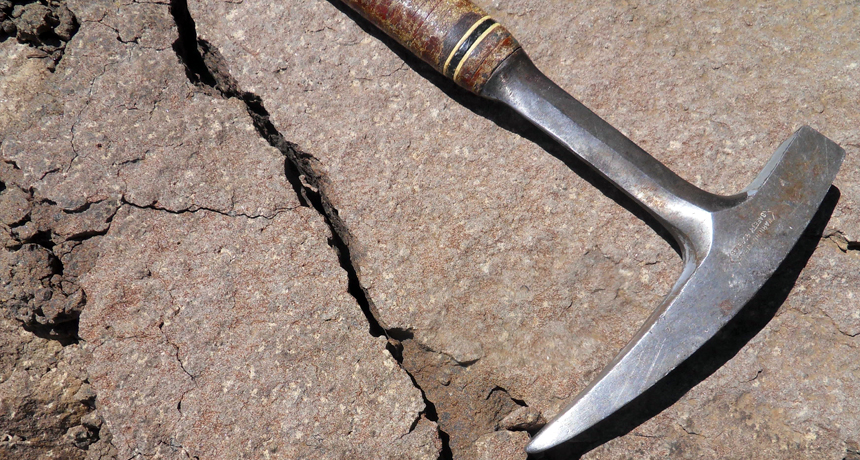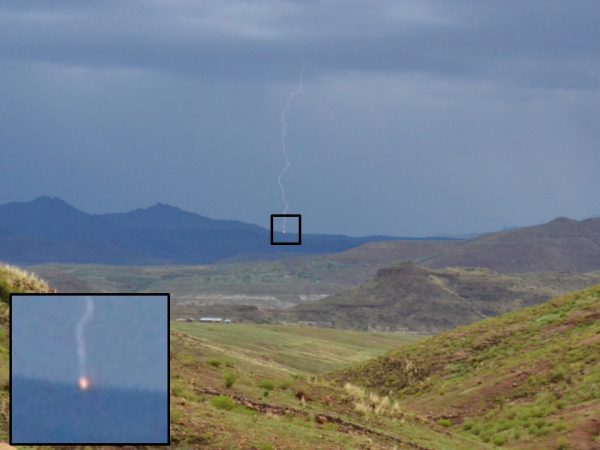Does lightning sculpt mountains?
A new study sparks debate about how much rubble on a mountainside has been blasted loose by powerful bolts from the sky

The fractured rocks seen at the tip of this geologist’s hammer mark the spot where lightning struck the boulder, says a team of scientists. Lightning strikes may play a substantial role in reshaping some mountains, they suggest in a new study.
Knight and Grab, Geomorphology (2014)
Share this:
- Share via email (Opens in new window) Email
- Click to share on Facebook (Opens in new window) Facebook
- Click to share on X (Opens in new window) X
- Click to share on Pinterest (Opens in new window) Pinterest
- Click to share on Reddit (Opens in new window) Reddit
- Share to Google Classroom (Opens in new window) Google Classroom
- Click to print (Opens in new window) Print
By Sid Perkins
There’s no doubt that ice can reshape mountains. Researchers in South Africa now suggest adding another major player: lightning.
They argue that the intense, momentary heat that lightning produces can crack apart mountain surfaces. This can slowly sculpt peaks, leaving rubble behind. Some critics, however, challenge whether lightning is really more than a bit player.
Jasper Knight and Stefan Grab of the University of the Witwatersrand in Johannesburg propose that lightning may be a major reshaper of mountains in the Jan. 1 issue of Geomorphology. They make this claim after studying a rugged area called Drakensberg. It’s a mountainous region in Lesotho, a country in southern Africa. There the pair found substantial amounts of rocky debris on the slopes.
In many areas, especially in polar regions and at high elevations, glaciers carve away parts of mountains. As these long-lived ice streams flow, they grind away at the bedrock below. This can break loose boulders that the glaciers then carry with them. Along the way, the glaciers and the rocky debris can gouge out broad, U-shaped valleys.
Ice can play a big role in reshaping rocks even in cold areas without glaciers. There, water seeps into cracks and crevasses in rocks. When it freezes, the ice expands. This can sometimes exert enough force to bust large rocks into jagged pieces.

But the mountain sites that Knight and Grab studied seldom freeze. They do, however, get plenty of thunderstorms. That got the researchers thinking: Could lightning be blasting the region’s rocks to pieces?
After all, some regions midway between the poles and tropics may get hit with 150 bolts of lightning per square kilometer each year. (That’s about 390 strikes per square mile.) On upwind mountain slopes where thunderstorms are especially common, rates of lightning strikes can be even higher.
And lightning is quite powerful. A bolt can heat the surrounding air, as well as any object it strikes, to a temperature approaching 30,000° Celsius in less than 1 millisecond (one-thousandth of a second). It can explode into steam any water on a rock. If that water is inside the rock, either soaked into its pores or stuck in a crack, the pressure increase as it flashes to steam could shatter rock.
Another side effect: Lightning’s intense heat can reset the magnetic field locked within a rock’s magnetic minerals.
Knight and Grab now report evidence of both at Drakensberg.
Mount-ing evidence
The pair studied jagged rocks at dozens of sites. Eventually, they focused on eight sites scattered across several peaks. All were within 1 kilometer of each other. Throughout these areas were many, many signs of lightning strikes, notes Knight.
Many rocks, for instance, seemed to be freshly broken. Also, no lichens grew on them. That last point makes sense, Knight says, because lightning can create temperatures high enough to quickly incinerate anything growing on a rock. (Lichens are not plants, but rather a blend of a fungus and an alga. They come in many shapes, colors and sizes, and they can grow in harsh environments. You may be most familiar with the flat, frilly types that grow on tree trunks, rocks and old tombstones.)
These seemingly fresh surfaces also were harder than similar rocks nearby. But that’s not because the rocks were “cooked” by lightning, Knight notes. It’s because chemicals in the air or dissolved in rainwater can soften exposed rock surfaces over time.
Finally, the researchers held a compass near these freshly broken rocks. It was the type of compass that hikers and explorers use. And at once, its needle moved. That was a sign that the rocks had a magnetic field. The closer the compass was held to the place where lightning had supposedly struck, the farther the needle moved, says Knight. That shows the area near the strike zone was magnetized differently than surrounding rocks.
“The new findings are intriguing,” says Olav Slaymaker at the University of British Columbia in Vancouver. As a geomorphologist, he studies Earth’s landscapes and the processes that shape them. Knight and Grab have shown without a doubt that lightning strikes have an effect on rocks, he says. However, he adds, “there are a lot of questions still to be answered.”
For instance, he notes, lightning is rare in some places but common in others. So maybe the small area that this team studied is unusual. Further field studies would be needed to make sure that lightning strikes are no more common here than at other sites in the area. Still, he argues, “geologists have not taken [lightning] as seriously as they might have.”
Perhaps. But geomorphologist Ian Meiklejohn does not buy the new study’s conclusions. He works at Rhodes University in Grahamstown, South Africa. Having studied the rocks in the Drakensberg area for many years, he argues that simple water erosion can produce the same results. “There’s no need to look at exotic explanations when regular ones will do,” he says.
What’s more, Knight and Grab focused on a tiny fraction of the Drakensberg region to explain what’s happening throughout these mountains generally. Finally, he contends that it is hard to tell whether recent lightning caused the magnetic changes noted by Knight and Grab. In fact, the magnetic changes could be very, very old. If that’s so, lightning may be shaping the mountains more slowly than Knight and Grab propose.
Considering all the evidence, “I think it’s okay to say lightning makes a few jagged rocks here and there,” Meiklejohn says. But when it comes to mountain sculpting, he suspects that lightning’s role “is minuscule.”
Power Words
algae Single-celled organisms, once considered plants, that grow in water and depend on sunlight to make their food.
erosion The process that removes rock and soil from one spot on Earth’s surface and then deposits the material elsewhere. Erosion can be exceptionally fast or exceedingly slow. Causes of erosion include wind, water (including rainfall and floods), the scouring action of glaciers, and the repeated cycles of freezing and thawing that often occur in some areas of the world.
fungus (plural: fungi) Any of a group of unicellular or multicellular, spore-producing organisms that feed on organic matter, both living and decaying. Molds, yeast and mushrooms are all types of fungi.
geology The study of Earth’s physical structure and substance, its history and the processes that act on it. People who work in this field are known as geologists. Planetary geology is the science of studying the same things about other planets.
geomorphology The study of Earth’s landscapes and the processes that shape them.
glacier A slow-moving river of ice hundreds or thousands of meters deep. Glaciers are found in mountain valleys and also form parts of ice sheets.
lichen A blend of a fungus and an alga. Neither of these organisms is a plant; the lichen isn’t a plant either.
magnetic field A region around a magnetic material where the force of magnetism acts.
pressure Force applied uniformly over a surface, measured as force per unit of area.






